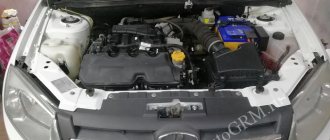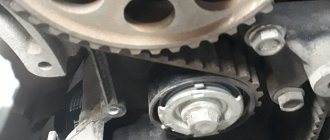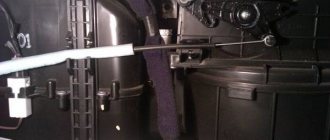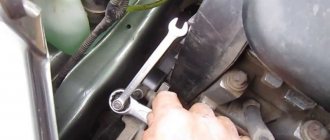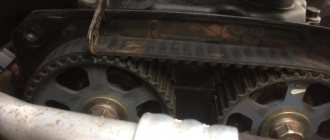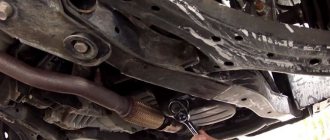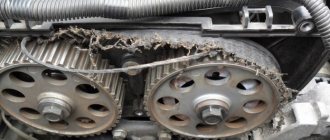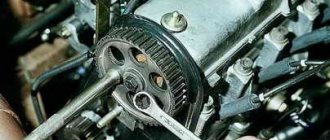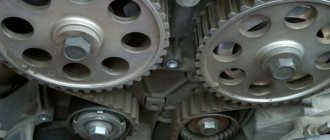The Hyundai Accent timing belt serves as the connecting link between the crankshaft and camshaft. There are few differences between belts for 8-valve and 16-valve engines - the latter have only 2 teeth more. Be sure to check compatibility before purchasing. It is also necessary to mention a small feature of the Accents - it has one camshaft pulley. But inside the cylinder head of 16-valve engines there are two toothed pulleys connected by a metal chain, which is lubricated with engine oil. This greatly simplifies the adjustment of the gas distribution mechanism, since the two camshafts will operate synchronously in any case.
Purpose of the timing belt
Timing belt for Hyundai Accent car
It consists of transmitting torque from the crankshaft to the camshaft and ensuring their continuous synchronous operation. Each of these shafts has toothed pulleys and the belt has teeth. This section of the belt completely eliminates its slipping on the pulleys and ensures reliable grip.
Main problem
The problem lies in the fact that in order to get to the belt itself and even just remove it, you have to do a lot of other work that takes both energy and time and destroys nerve cells.
Therefore, for those people who have little time or do not want to waste their nerves, we recommend entrusting this important work to a service station, because today the timing belt is one of the important components of modern car engines, and its correct replacement will greatly influence the smooth operation of the engine. further.
In addition, the timing belt operates under very difficult conditions, and the car owner is obliged to constantly monitor its condition and, at the slightest suspicion of its malfunction, immediately take replacement measures.
Signs and reasons for replacement
According to car service specialists, the timing belt on a Hyundai Accent should be replaced every 50 thousand kilometers. The same figure is indicated in the car's operating instructions. But the owners of these cars themselves recommend doing this earlier - every 40 thousand km. There are a number of signs indicating the need for urgent belt replacement:
- The car's engine is unstable, and clouds of black smoke periodically fly out of the exhaust pipe.
- The engine starts with great difficulty (although a reservation should be made here: this malfunction may be associated not only with a worn timing belt).
- Severe overheating of the engine is observed, accompanied by increased consumption of engine oil and antifreeze.
- During engine operation, characteristic clicks and other extraneous sounds are heard.
- Cracks appeared on the timing belt, between the teeth, visible to the naked eye.
- A visual inspection revealed that small longitudinal delaminations had appeared in the belt.
This is interesting: Features of disc and drum brakes
Suspension
By 80 thousand km it will be necessary to change the stabilizer struts along with the bushings. If the car is driven on rough roads, the shock absorbers may fail.
In addition, you need to pay attention to the brake cylinders; they may be damp. In addition, if the car was driven on bad roads, the wheel bearings fly
If you hear a characteristic sound, then it’s time to change them. The automatic transmission of the Alpha-Beta series can present a surprise at the end of 100 thousand km.
The car can also go into catastrophic mode. The complaint will most likely be about overheating. It is necessary to clean the radiator honeycombs, sweep away the filter and oil.
If the box does not provide indicators of fate, then you need to go to the service center. Indeed, I note that the service will solve this problem quickly and inexpensively.
Like any car, the Hyundai Pronouncement has its pros and cons. Specifically, the car costs its own money and earns it honestly. Indeed, finding a “living” reprimand is becoming more and more difficult from year to year. It goes without saying, if the design of the car does not matter to you, you can safely consider the Reprimand as a good option for a budget-friendly, reliable aftermarket car. When purchasing a supported Reprimand, it is worth spending time searching for a good option, recognizing its “sore spots” and eliminating shortcomings.
Then the Reprimand will serve you for quite a long time.
Instructions
Required Tools
- Set of open-end wrenches.
- Set of socket heads with a wrench.
- Jack.
- New timing belt.
- Flat blade screwdriver (medium size).
Sequencing
- The hood of the car is opened and, using a 10-mm open-end wrench, the 4 bolts located on the pump pulley are loosened.
You can see the pump shaft with 4 bolts that need to be loosened - The lower nut on the generator is loosened (there is only one there). After this, the tension of the generator belt is reduced and it can be easily removed manually.
- Using a 10mm socket, remove the upper half of the timing belt protective casing.
The upper timing case cover, the bolts are unscrewed, can be removed - Now the right front wheel of the car is jacked up and removed. This gives access to a plastic protective panel behind which the timing pulleys are located.
- The pulleys must be installed in exact accordance with the marks (the mark on each pulley must match the mark on the timing case). After the shafts are correctly aligned to the marks, cylinder 1 of the engine is set to top dead center.
The lower pulley coincides with the mark in the form of the letter “T”
The mark on the shaft pulley matches the red mark on the housing - Now the screws securing the crankshaft pulley are unscrewed and the pulley is removed. This opens up access to the bolts that secure the lower half of the timing belt guard.
The bolts of the lower protective cover of the casing are unscrewed and the cover is removed - Using a 14mm socket, unscrew the screw on the idler roller. After this, the timing belt tension weakens and it can be easily removed. Then, using a 12mm socket, unscrew all the screws on the tension roller.
- Before installing a new belt, all previously removed rollers are installed in their original places, and they must be mounted so that the marks on their pulleys and on the timing case coincide. This is a must. After installing all the rollers, the crankshaft is rotated 3-4 turns, and the coincidence of the marks is carefully monitored. Discrepancies are not allowed. If they are not there, a new timing belt is installed, after which all components are reassembled.
Body repair Hyundai Accent
Like every car, the Accent tends to succumb to corrosion. This is especially common in cars manufactured before 2008. The sills and wheel arches shoot out first. Thresholds must be replaced, but only if the owner has welding equipment and certain skills.
To avoid, or at least delay the critical moment of the body’s condition, you should take care of this in advance. When purchasing even a new car, experts recommend anti-corrosion treatment of the bottom and fender liners, and pouring anti-corrosion mastics into the cavities of the sills and body.
Gutter gutters and engine compartment air ducts require special care in processing. Atmospheric water often stagnates there, and corrosion manifests itself most clearly at first there. It is also recommended to carry out anti-corrosion treatment of door cavities, especially focusing on the lower corner cavities, where corrosion most often occurs.
If simple engine and body maintenance work is carried out in a timely manner, the car will last for a long time and will be no worse than its Korean relatives. In capable hands, even an Accent will be able to please the owner for a long time with uninterrupted operation and long mileage.
Features of operation on 8- and 16-valve engines
- As you know, Hyundai Accent cars are equipped with both 8-valve and 16-valve engines. The timing belt replacement instructions given above are for 16-valve vehicles. It is also suitable for 8-valve models, since the sequence of actions will be the same. There is only one nuance: the length of the timing belt. On 8-valve models it is 2 cm shorter. And this point must be taken into account when purchasing (as a rule, the packages of Hyundai Accent belts indicate which engines they are intended for).
- When buying a belt, you should carefully inspect it, and most importantly, it must be checked for bending. This will not be difficult to do, since these belts are sold in transparent plastic packaging. If, with a strong bend, thin, hair-like transverse cracks are visible at the base of the teeth, you should refrain from purchasing such a belt. This defect can appear on old belts manufactured several years ago. Therefore, when purchasing, you should pay attention not only to the condition of the belt itself, but also to the date of its manufacture (it is usually indicated on the packaging)
- Compliance with the marks when installing a new belt is the most important condition. If the shafts in the engine are incorrectly aligned, then when the engine starts, all its valves will be damaged. The timing diagram for the Hyundai Accent is shown below.
This is interesting: Mercedes-Benz all-terrain convertible vehicle, which is similar to the GAZ-53
Layout of marks on timing pulleys
As you can see from this article, replacing a timing belt is a long procedure. For a novice car enthusiast, it may seem too complicated. Nevertheless, there is nothing complicated about it, especially if you follow the instructions outlined above exactly. There are two key points: you need to buy the right belt, and then accurately set the marks on the pulleys. The remaining operations should not cause any difficulties.
Copywriter with five years of experience. (1 vote, average: 4 out of 5)
Engine repair Hyundai Accent (Accent) price:
- Engine repair
- Oil seals
- Cooling radiator
- timing belt
- Flushing systems
- Camshaft
- Crankshaft
- Drive belt
- Pistons
- Cylinders
- Valves
- Pump
- Candles
- Turbine
- Additional services
Hyundai Accent engine repair
| Engine repair | Cost (RUB) |
| Engine overhaul | from 31680 |
| Engine overhaul | from 31680 |
| Engine flushing | from 1900 |
| Engine diagnostics | from 790 |
| Engine Maintenance | from 1580 |
| Removing and installing the engine | from 7130 |
| Engine compression test | from 1580 |
| Replacing the engine mount | from 790 |
Repair of Hyundai Accent cooling radiators
| Cooling radiator | Cost (RUB) |
| Cooling radiator repair | from 1580 |
| Radiator fan repair | from 1270 |
| Replacing the radiator fan | from 1110 |
| Replacing the cooling radiator | from 1900 |
| Engine radiator replacement | from 1740 |
| Radiator cleaning | from 4750 |
| Radiator washing | from 1580 |
Flushing Hyundai Accent car systems
| Flushing systems | Cost (RUB) |
| Washing car systems | from 1270 |
| Flushing the cooling system | from 2380 |
| Flushing the fuel system | from 3170 |
| Flushing the throttle valve | from 3170 |
| Injector flushing | from 3170 |
Hyundai Accent crankshaft repair
| Crankshaft | Cost (RUB) |
| Repair and replacement of the crankshaft | from 4750 |
| Replacing the front crankshaft oil seal | from 1900 |
| Replacing the rear crankshaft oil seal | from 1900 |
| Crankshaft boring | from 7920 |
| Replacing the crankshaft (crankshaft) | from 19010 |
| Replacing engine bearings | from 7920 |
Hyundai Accent drive belt repair
| Drive belt | Cost (RUB) |
| Replacing the drive belt | from 1270 |
| Replacing the drive belt tensioner roller | from 1270 |
Hyundai Accent Piston Repair
| Pistons | Cost (RUB) |
| Replacing piston rings | from 11090 |
| Replacing the piston group | from 12670 |
| Repair of cylinder-piston group | from 19010 |
Hyundai Accent cylinder repair
| Cylinders | Cost (RUB) |
| Honing the cylinder block | from 6000 |
| Engine cylinder block repair | from 11090 |
| Replacing the cylinder head | from 11090 |
| Engine cylinder head repair | from 7920 |
| Replacing the head gasket (cylinder head) | from 5540 |
Hyundai Accent spark plug repair
| Candles | Cost (RUB) |
| Replacing glow plugs | from 1580 |
| Replacing spark plug well gaskets | from 1270 |
| Replacing spark plugs | from 1270 |
Additional services Hyundai Accent
| Additional services | Cost (RUB) |
| Cooling system repair | from 2400 |
| Replacing the engine oil pan | from 1430 |
| Replacing hydraulic compensators | from 5540 |
| Replacing engine mounts | from 4750 |
| Fuel system repair | from 3170 |
| Replacing the engine pump | from 1580 |
| Replacing the valve cover gasket | from 1580 |
| Replacing the pan gasket | from 1900 |
| ★ FREE DIAGNOSTICS of Hyundai Accent using 43 parameters. The offer is valid for the first time or repair in our car service center "Tokyo Service". More details |
Free diagnostics Get a consultation Request for a tow truck
Free diagnostics of Hyundai Accent
Comprehensive diagnostics using 43 points
Antibacterial treatment of the interior
Antibacterial treatment of the interior with ozonization 1500 rub.
Oil change / filters / spark plugs from 3500 rub.
Changing engine oil, spark plugs + filters (oil, air, cabin)/
Free replacement of technical fluids
When purchasing Hyundai Accent consumables in our car service center. Replacement of any technical fluid is free.
Washing of cooling radiators 6999 rub.
The price includes - Removal, cleaning, special equipment and installation
Tire service + wheel alignment
Tire fitting and alignment of Hyundai Accent at a super price from 5500₽
Useful tips
- The timing belt should be replaced with a cooled engine using special tools.
- In order to independently check whether the belt is tensioned enough, you will need to remove the lower and upper parts of the timing belt guard. Press the belt from the side of the idler roller with a force of 5 kg/s. The tension roller adjusting bolt will serve as a guide; when the belt bends to the middle of its head, the tension will correspond to the norm.
- When planning a timing belt replacement, if the car's mileage has reached 50,000 km, then in addition to replacing the belt and rollers itself, it is worth replacing the belts of the drive units - generator, air conditioner and power steering. If necessary, immediately change the spark plugs, fuel filter, oil filter and oil.
Mechanism lubrication system
To reduce the cost and simplify the engine design, the camshaft is located in the cylinder head. Rotation occurs in several sliding bearings, made like supports, which can be one-piece or detachable. But sometimes they use liners for support. To prevent the camshaft from moving, there is a special thrust bearing on the drive side. All bearings are supplied with engine oil under pressure from the lubrication system. Engines are of two types according to the type of camshaft arrangement:
- single shaft (SOHC);
- with two shafts (DOHC).
The most popular is the second system. By using a larger number of valves, engine power is increased and its dynamic characteristics are improved. The camshaft drive on most modern engines is an elastic belt. Less commonly used are gear or chain drives.
The drive is necessary to ensure correct rotation of the camshaft, because it must rotate only 180 degrees in one revolution of the crankshaft. The chain is often used in the drive system, as it has the main advantage of durability. But it makes quite a lot of noise during operation and needs lubrication. And the chain is also more difficult to replace.
As for the timing belt, it does not need lubrication. And to be more precise, it is even contraindicated. The resource of the belt is very limited, but some copies can go 200 thousand km. In addition to the camshaft, it can also drive auxiliary mechanisms: pump, high pressure fuel pump (on diesel engines), oil pump, air conditioning compressor.
